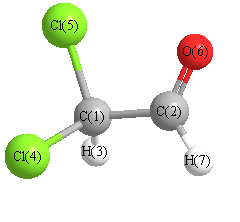Jump to
S1C2
Vibrational Frequencies calculated at CCSD/aug-cc-pVDZ
Geometric Data calculated at CCSD/aug-cc-pVDZ
Electronic energy levels
Charges, Dipole, Quadrupole and Polarizability
Jump to
S1C1
Energy calculated at CCSD/aug-cc-pVDZ
| | hartrees |
|---|
| Energy at 0K | -1071.570024 |
| Energy at 298.15K | |
| HF Energy | -1070.768514 |
| Nuclear repulsion energy | 264.353054 |
The energy at 298.15K was derived from the energy at 0K
and an integrated heat capacity that used the calculated vibrational frequencies.
Vibrational Frequencies calculated at CCSD/aug-cc-pVDZ
| Mode Number |
Symmetry |
Frequency
(cm-1) |
Scaled Frequency
(cm-1) |
IR Intensities
(km mol-1) |
Raman Act
(Å4/u) |
Dep P |
Dep U |
|---|
| 1 |
A |
3131 |
3017 |
4.75 |
|
|
|
| 2 |
A |
3004 |
2894 |
40.37 |
|
|
|
| 3 |
A |
1817 |
1751 |
115.85 |
|
|
|
| 4 |
A |
1393 |
1342 |
13.20 |
|
|
|
| 5 |
A |
1273 |
1227 |
9.07 |
|
|
|
| 6 |
A |
1228 |
1183 |
12.93 |
|
|
|
| 7 |
A |
1044 |
1006 |
13.12 |
|
|
|
| 8 |
A |
945 |
910 |
4.03 |
|
|
|
| 9 |
A |
832 |
801 |
70.91 |
|
|
|
| 10 |
A |
652 |
629 |
31.86 |
|
|
|
| 11 |
A |
613 |
591 |
27.11 |
|
|
|
| 12 |
A |
348 |
335 |
1.08 |
|
|
|
| 13 |
A |
278 |
268 |
3.16 |
|
|
|
| 14 |
A |
221 |
213 |
3.19 |
|
|
|
| 15 |
A |
83 |
80 |
10.97 |
|
|
|
Unscaled Zero Point Vibrational Energy (zpe) 8431.4 cm
-1
Scaled (by 0.9634) Zero Point Vibrational Energy (zpe) 8122.8 cm
-1
See section
III.C.1 List or set vibrational scaling factors
to change the scale factors used here.
See section
III.C.2
Calculate a vibrational scaling factor for a given set of molecules
to determine the least squares best scaling factor.
Geometric Data calculated at CCSD/aug-cc-pVDZ
Point Group is C1
Cartesians (Å)
| Atom |
x (Å) |
y (Å) |
z (Å) |
|---|
| C1 |
0.096 |
-0.033 |
0.523 |
| C2 |
-0.734 |
-1.284 |
0.184 |
| H3 |
0.223 |
0.046 |
1.612 |
| Cl4 |
1.743 |
-0.280 |
-0.167 |
| Cl5 |
-0.654 |
1.465 |
-0.058 |
| O6 |
-1.836 |
-1.257 |
-0.309 |
| H7 |
-0.217 |
-2.233 |
0.451 |
Atom - Atom Distances (Å)
| |
C1 |
C2 |
H3 |
Cl4 |
Cl5 |
O6 |
H7 |
| C1 | | 1.5382 | 1.0994 | 1.8023 | 1.7740 | 2.4338 | 2.2230 |
C2 | 1.5382 | | 2.1734 | 2.6947 | 2.7607 | 1.2081 | 1.1137 | H3 | 1.0994 | 2.1734 | | 2.3622 | 2.3609 | 3.1034 | 2.5954 | Cl4 | 1.8023 | 2.6947 | 2.3622 | | 2.9670 | 3.7126 | 2.8348 | Cl5 | 1.7740 | 2.7607 | 2.3609 | 2.9670 | | 2.9787 | 3.7590 | O6 | 2.4338 | 1.2081 | 3.1034 | 3.7126 | 2.9787 | | 2.0380 | H7 | 2.2230 | 1.1137 | 2.5954 | 2.8348 | 3.7590 | 2.0380 | |
 More geometry information
More geometry information
Calculated Bond Angles
| atom1 |
atom2 |
atom3 |
angle |
|
atom1 |
atom2 |
atom3 |
angle |
| C1 |
C2 |
O6 |
124.364 |
|
C1 |
C2 |
H7 |
112.939 |
| C2 |
C1 |
H3 |
109.855 |
|
C2 |
C1 |
Cl4 |
107.284 |
| C2 |
C1 |
Cl5 |
112.728 |
|
H3 |
C1 |
Cl4 |
106.466 |
| H3 |
C1 |
Cl5 |
108.201 |
|
Cl4 |
C1 |
Cl5 |
112.120 |
| O6 |
C2 |
H7 |
122.693 |
|
Electronic energy levels
Charges, Dipole, Quadrupole and Polarizability
